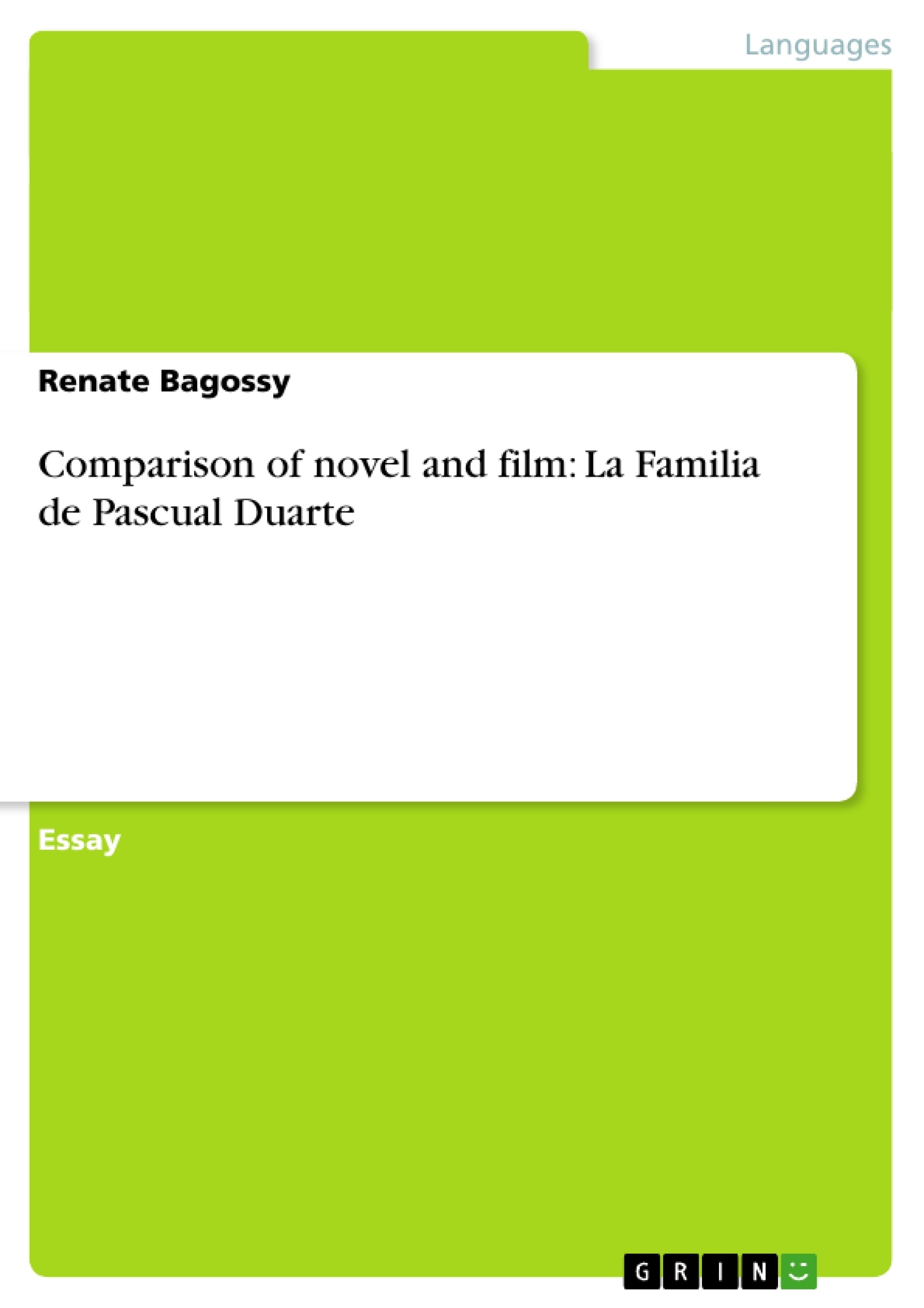The film version of the novel La Familia de Pascual Duarte by Camilo José Cela is written and directed by Ricardo Franco Rubio and was first screened in 1975. Without any background knowledge the film seems hard to follow, boring and depressing, but by watching it with background knowledge, just as Spanish history, Spanish cinema history, the novel itself or by watching the film for the second time one can realise, that it is a very demanding film full of symbols, of small important details which all have a second meaning, a hidden meaning.
Turning a novel into a film is a very complex task, one cannot just take the book and, without changing anything, trying to make a film out of it. There are huge differences between reading a book and watching the same thing on screen: ”the analysis of a literary text reveals the manner in which linguistic and literary tools such as graphemes, syntax, tropes, shadings, and narrative strategies create a story and its characters. The cinematic rendering of that verbal fiction is accomplished by means of cinematic tools such as mise-en-scéne, photography and camera work, editing, sound, narrative strategies, and choice of actors.”1 So there must be some changes, because some details of books that are good to read, are not necessarily good to watch!
It is difficult to say, when is a film version of a novel ”good” or ”bad”, because the filmmakers work with other instruments, in a ”good” film version we do not see exactly the same, that we imagined while reading the book. By comparing the novel to the film there are similarities and differences, in the film there are characters and scenes left out but also things added, which do not appear in the book. ”Novel and film share several basic structural elements. 1) Both focus on the text′s central character, Pascual Duarte, an agricultural labourer living with his family in an isolated, unnamed village in Extremadura, Spain. The time frame is principally the first three decades of the twentieth century. 2) Both texts present a case of individual violence that, while enacted within a circumscribed social sphere, resonates with meaning on a national level. 3) Both texts, hindered by the censorship of the Franco years, mask the significance of the social and historical context for criminal behaviour. 4) Both texts actively engage the receptor in the task of providing a motive for the extremely violent behaviour exhibited by the protagonist.”2
Table of Contents
- Comparison of novel and film: La Familia de Pascual Duarte
- Turning a novel into a film
- Similarities and Differences
- The Narrator
- The Structure of the Film
- Violence in the Film
- Characters and Scenes
- Pascual's Motives
- Don Jesús
- Political Situation
- The Story of Abraham and Isaac
- Visual Representation
- Music and Atmosphere
- Conclusion
Objectives and Key Themes
This paper examines the film adaptation of Camilo José Cela’s novel, La Familia de Pascual Duarte, directed by Ricardo Franco Rubio. It analyzes the challenges of translating a novel into a cinematic medium, exploring the differences in narrative strategies, characterization, and the depiction of violence. The paper also examines the film’s thematic focus on the complexities of individual violence, the social and historical context of the Franco era, and the psychological motivations of the protagonist.
- Adaptation of a novel into a film
- Violence and its social context
- Character development and motivations
- Narrative strategies and cinematic techniques
- Thematic interpretation of the film
Chapter Summaries
The paper begins by outlining the fundamental differences between reading a novel and watching a film adaptation. It highlights the challenges faced by filmmakers in translating a literary work into a cinematic format, particularly in terms of narrative structure and character development. The paper then explores the similarities and differences between the novel and film versions of La Familia de Pascual Duarte. It examines the portrayal of Pascual Duarte, the central character, in both mediums, focusing on his violent acts and the motivations behind them. The paper analyzes the impact of the first-person narration in the novel and the more complex, fragmented narrative structure of the film.
The paper then delves into the depiction of violence in the film and its relation to the social and political context of the Franco era. It explores how the film, constrained by censorship, hints at the socioeconomic factors influencing Pascual's violent behavior without explicitly stating them. The paper also examines the characterization of Don Jesús, a wealthy individual who represents a stark contrast to the impoverished villagers, and the role he plays in the film's narrative. Finally, the paper analyzes the film's visual and auditory elements, highlighting the use of symbolism, music, and cinematography to create a sense of melancholy and stagnation, mirroring the bleak existence of the characters.
Keywords
This analysis of the film adaptation of La Familia de Pascual Duarte focuses on the themes of violence, adaptation, character development, narrative structure, and sociopolitical context. The paper also explores the use of cinematic techniques, such as mise-en-scène, camera work, editing, and sound, to convey the film's themes and atmosphere. In addition to these keywords, the paper draws upon insights from Patricia J. Santoro's work on novel-to-film adaptations, specifically her analysis of La Familia de Pascual Duarte and Los santos inocentes.
- Citar trabajo
- Renate Bagossy (Autor), 2002, Comparison of novel and film: La Familia de Pascual Duarte, Múnich, GRIN Verlag, https://www.grin.com/document/26387



